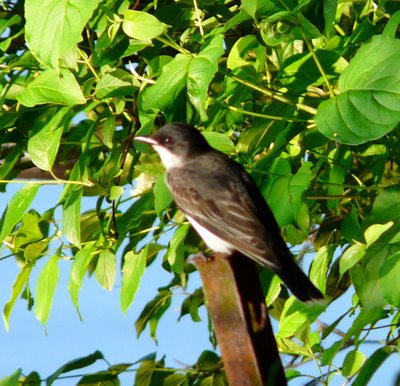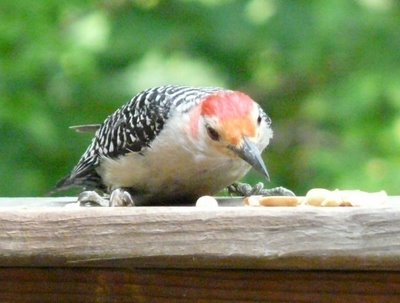The Blue Jays take a peanut to a tree branch, and spend the next minute pecking it apart and eating it. The Chickadee does the same thinng with a sunflower seed.
Sunday, June 29, 2008
Chickadee with a seed at the feeder
The Blue Jays take a peanut to a tree branch, and spend the next minute pecking it apart and eating it. The Chickadee does the same thinng with a sunflower seed.
Wednesday, June 25, 2008
Can you spot the night herons?
Monday, June 23, 2008
Two downy woodpeckers
Here is a photo of two downy woodpeckers at the feeder. We think the one on the top with the red head is a juvenile male and the lower one its mother. We've been watching this pair, sometimes joined by a third male woodpecker, for about a week. The female occasionally feeds the male and he doesn't fly very well so we think he's a juvenile.
Another Night Heron Picture
Here's another picture of the night heron. This time, he was on the other side of the bridge, fishing from a pile of sticks.
Labels:
Black-crowned Night Heron,
Heron,
Summer Birds
Thursday, June 19, 2008
Black-crowned Night Heron
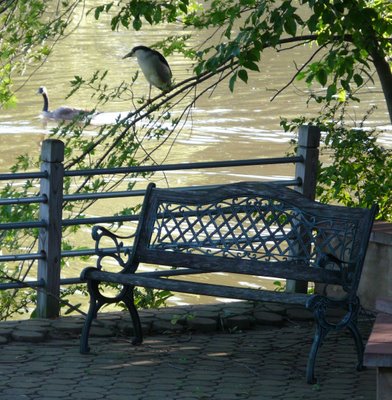
Here's a picture of the Black-crowned Night Heron waiting for a fish to come by. We like that way that his world blends with ours in this photo. We have better night heron photos elsewhere, but not a better story. In the evening, we went for a walk and came upon this heron again at the dam. He had a fish that was at least 6 inches long and 4 inches wide in his mouth still flopping about. We watched him for a while, and he positioned the fish and then swallowed it whole. Didn't he ever hear that your not supposed to eat anything bigger than your head?
Labels:
Black-crowned Night Heron,
Heron,
Spring Birds
Monday, June 16, 2008
Sunday, June 15, 2008
Blue Jays eating nuts
Mike got the nickname peanut man in Brazil from sharing his peanuts with some spider monkeys. This weekend he left some peanuts in the shell on the deck railing. Some blue jays quickly discovered them, carrying them one by one to nearby trees to open and eat. Then something weird happened. A blue jay brought one of the nuts back, placed it on the railing and flew off. It had pecked a hole in it, but didn't get the nuts out. So Mike shelled it and some others and the bird came back. Not content with half a peanut, it stuffed several in its mouth, rearranged them and flew off. We also tried marconi almonds, and pistachios. They liked them all. Next week, it's hazelnuts.
Another Nut
Tuesday, June 10, 2008
Blue Heron eating something
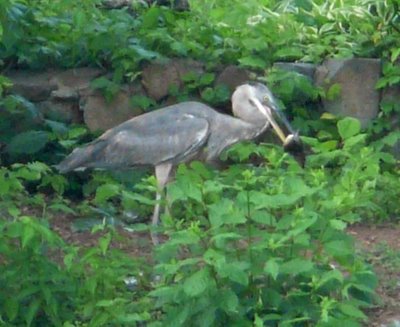
Chris noticed this large blue heron make a graceful landing on the other side of the lake. A large blue heron was a common visitor last fall before we started blogging and Mike has been wanting to take his picture, even if it's from a distance. He took a few and then was surprised to find out that he caught it eating something rather large. At first we thought it might be a muskrat, which herons have been known to eat, but now we think it may be a large fish. Whatever it is, it looks too big for it.
Sunday, June 8, 2008
Baby Mallards
Geese
The Canada Geese are by far the most numerous waterfowl on the lake. They can be a bit of a nuisance and are the reason that most people have fences on the lakefront.
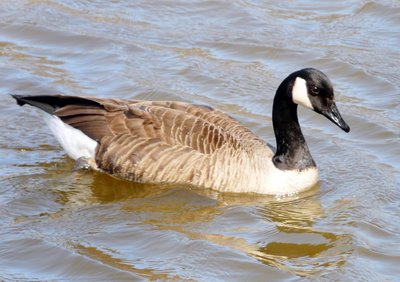
"Whitey," as we call her, is a white goose. We aren't sure what type of goose she is. At first, we thought she was a snow goose, but the snow goose has a much different shape to its beak. Whitey is more domesticated than the other geese and we speculate that she may have been a domestic goose that is now out in the wild. It's hard to call her wild. She seems to enjoy handouts more than the wild geese. She notices when the first light goes on in the morning and appears just in case we have something. She'll get up on the dock and attempt to join in a snack or a conversation. She'll get involved in our yard work.
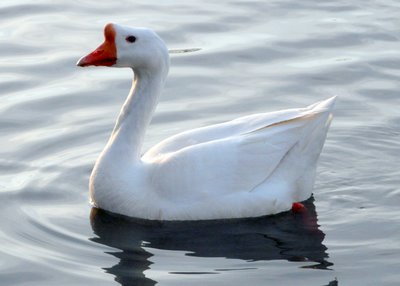
Some neighbors have told us that in the past she's laid eggs and had goslings. There don't appear to be any this year. We have seen her mating with the Canada geese. So that brings up the question as to why there are some geese with white heads but mostly Canada Goose markings. We've read that Canada Geese can interbreed with Snow Geese and produce goslings with similar markings. We don't know if these are Whitey's offspring.
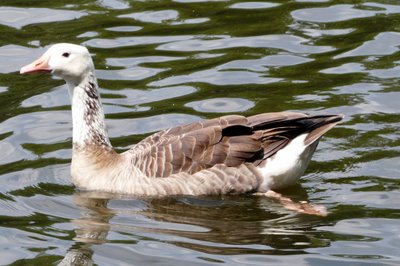
Below is another goose with unusual markings (at least to us). The goose above is the same size as the Canada Goose. The one below is noticeably larger, but hangs out with Whitey often as well as the Canada Geese.
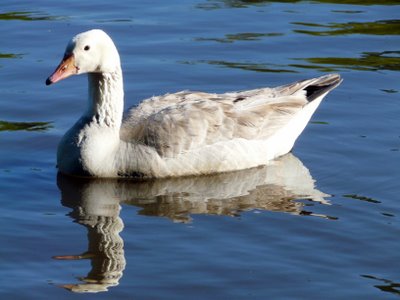
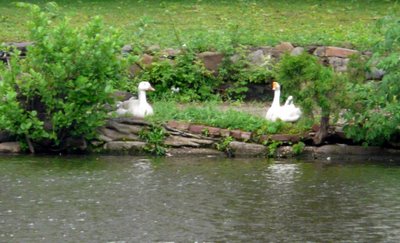
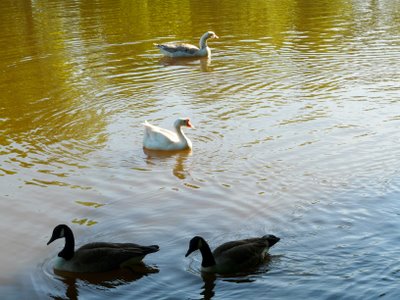
We really don't know what is going on. If you do, leave a comment (by clicking on the word comments below as in "0 comments" or "1 comment").
Canada Goose
"Whitey," as we call her, is a white goose. We aren't sure what type of goose she is. At first, we thought she was a snow goose, but the snow goose has a much different shape to its beak. Whitey is more domesticated than the other geese and we speculate that she may have been a domestic goose that is now out in the wild. It's hard to call her wild. She seems to enjoy handouts more than the wild geese. She notices when the first light goes on in the morning and appears just in case we have something. She'll get up on the dock and attempt to join in a snack or a conversation. She'll get involved in our yard work.
Whitey
Some neighbors have told us that in the past she's laid eggs and had goslings. There don't appear to be any this year. We have seen her mating with the Canada geese. So that brings up the question as to why there are some geese with white heads but mostly Canada Goose markings. We've read that Canada Geese can interbreed with Snow Geese and produce goslings with similar markings. We don't know if these are Whitey's offspring.

Hybrid Goose?
Below is another goose with unusual markings (at least to us). The goose above is the same size as the Canada Goose. The one below is noticeably larger, but hangs out with Whitey often as well as the Canada Geese.
Hybrid Goose?
Whitey and the larger hybrid goose
All Together Now
We really don't know what is going on. If you do, leave a comment (by clicking on the word comments below as in "0 comments" or "1 comment").
Thursday, June 5, 2008
Turtles in Love
When Mike got home tonight, he spotted something unusual in the lake. At first he thought it was the muskrat, but then it appeared to be an otter. As he got closer, and watched for a while, he was surprised to see that it was two turtles. Photos don't really do this justice, so there are two videos. The turtles did swim off, unharmed.
Click on the links below for the videos. They are fairly large, but worth the wait if you are a turtle lover.
Turtles (quicktime)
More Turtles
Brown-headed Cowbird
Tuesday, June 3, 2008
Monday, June 2, 2008
Baby Blue Jays

We were out on a walk this morning when we encountered two baby blue jays under the watchful eye of a mother blue jay. Here are a few pictures. They hopped around a little and even flew (or wing-assisted jumped) from branch to branch on a small tree. The pictures are high resolution, so if you click on them, you'll see larger than life-sized details.
Sunday, June 1, 2008
Juvenile Double-crested Cormorant
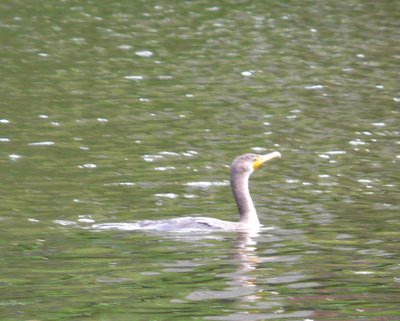
We took these cormorant photos over the weekend. He was swimming by Saturday and standing on a branch on Sunday. The juvenile Double-crested Cormorant has a lighter color, particularly on the chest than the adults. We can't see any crests on the head, but our bird book indicates only the double-crested gets this light.
Labels:
Cormorant,
Double-crested Cormorant,
Spring Birds
Oriole
We've been catching glimpses of an Oriole for a week or two. We've also been hearing a new bird song. We finally saw a pair of Orioles long enough to get some acceptable photos today. Orioles like sitting among the leaves making them hard to spot. We are debating whether it is a Baltimore Oriole or an Orchard Oriole.
Next on our wish list is a green heron we've spotted flying twice. We are also hoping for night heron chicks since we learned that they only fish in the day and have a white "pony tail" during breeding season. Oh, and a male wood duck is back. Here's the back of his head just as he flew away from Mike's "rush and flush" photographic technique. At least he found the camera without waking Chris up.
Juvenile Canada Goose
Juvenile Robin
Subscribe to:
Posts (Atom)
